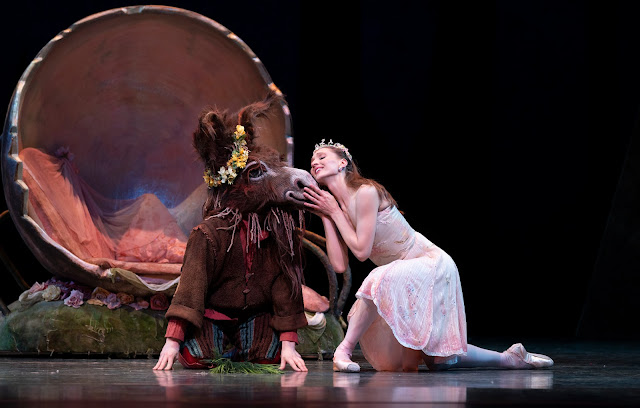 |
| Amanda Morgan photo @ Kenya Shakoor |
Amanda Morgan is having a moment.
More accurately, she’s having a year of moments: from last
summer’s grant to fund a series of open-air dance performances in Seattle
parks, to her promotion to the rank of Soloist at Pacific Northwest Ballet last September, to
her upcoming Seattle Project show, Chapters, at Northwest Film Forum.
I got to thinking about Amanda last weekend at a performance of PNB’s A
Midsummer Night’s Dream. She was dancing the role of
Hippolyta; in the first act she—accompanied by a pack of dogs—leaps around the stage with
a golden crossbow in her hand. (I don’t recall this particular character in Shakespeare’s
original text, but as one former ballerina told me ‘(choreographer) George
Balanchine liked to make roles for tall women.’)
.jpg) |
| Amanda as Hippolyta in George Balanchine's A Midsummer Night's Dream photo @ Angela Sterling |
Watching Amanda unfold those long, LONG, legs of hers as she
jeted into the wings, I got to thinking how far she’s come in the years that
I’ve been watching her dance.
I first met Amanda in 2018, two years after she joined PNB
as an apprentice. At the time she was making a dance for the company’s
Professional Division students to perform at their annual spring Next Step
performance. She wasn’t much older than 22.
Of course, I’d seen her onstage before that. She’s over
5’ 10”, so even in a ballet company that’s had its share of tall dancers, her
height is distinctive. Not only that. At the time, Amanda was the only Black
woman in the company, so of course you noticed her onstage.
 |
| Amanda Morgan in class at PNB photo @ Megan Farmer for KUOW radio |
Over the years I’ve wondered about her ballet future. She’d
once mentioned to me that she, herself, was unclear about where her artistic
path would take her. I think she felt a bit outside the white ballet world.
In 2019, Amanda founded the Seattle Project, a multi-arts
nonprofit that would feature work by BIPOC and queer creators, including
herself. When the pandemic hit and PNB was sidelined for months, Amanda
poured her energies into making her own work. The summer of 2020 saw her
collaborate with Nia-Amina Minor on a film for Seattle Dance Collective, Musings.

Amanda as Myrtha, Queen of the Wilis in PNB's 2023 production of Giselle
photo @ Angela Sterling
Since Amanda’s PNB promotion last fall, I’ve watched her
take on new ballet challenges. Perhaps the toughest is my favorite role
in Giselle; Myrtha, Queen of the Wilis. Myrtha and her band of jilted
women—all dead--haunt the forest after dark. The role is both technically and
dramatically challenging and it was a thrill to see Amanda perform it on successfully.
She was a standout in Crystal Pite’s The Seasons’ Canon
last November, and although I didn’t see it, she also debuted as the Sugar Plum
Fairy in Balanchine’s Nutcracker.
 |
| Amanda, center, with PNB company members in Crystal Pite's The Seasons' Canon. Photo @ Angela Sterling |
With all these new roles to tackle, you could excuse
Amanda for letting her own choreography slide. Instead, she’s been working on
her new piece, Chapters. The project explores the intersection of Blackness and
femininity, as well as personal history, and features work by five self-identified Black femme artists:
Amanda, Nia-Amina Minor, Akoiya Harris, Kenya Shakoor and PNB company member
Ashton Edwards.
[A word about Ashton, who’s been a rising force since
joining the ballet company as an apprentice in 2021. We’ve seen Ashton in an
array of works: pointe roles in the big ballets, a fabulous duet with Luther
DeMeyer in Justin Peck’s sneaker ballet The Times Are Racing, and most
recently as a magical Puck in Balanchine’s Midsummer.]
 |
| A completely extraneous--but fabulous--photo of Ashton Edwards as Puck photo @ Angela Sterling |
Despite Amanda’s ballet accomplishments, she seems
determined to forge ahead with her own creative endeavors, honing both her
choreographic skills and her self-producing chops.
You can check out both of her worlds in the coming weeks. Seattle Project's Chapters
will be at Northwest Film Forum May 5-6.
And PNB has one more program on tap this artistic season: Worlds to Come, a mixed bill featuring new work by Kiyon Ross (former PNB soloist, now company Associate Artistic Director) and internationally acclaimed Annabelle Lopez Ochoa. The program also features the live stage debut of Edwaard Liang's The Veil Between Worlds. It’s onstage June 2-11 at McCaw Hall








